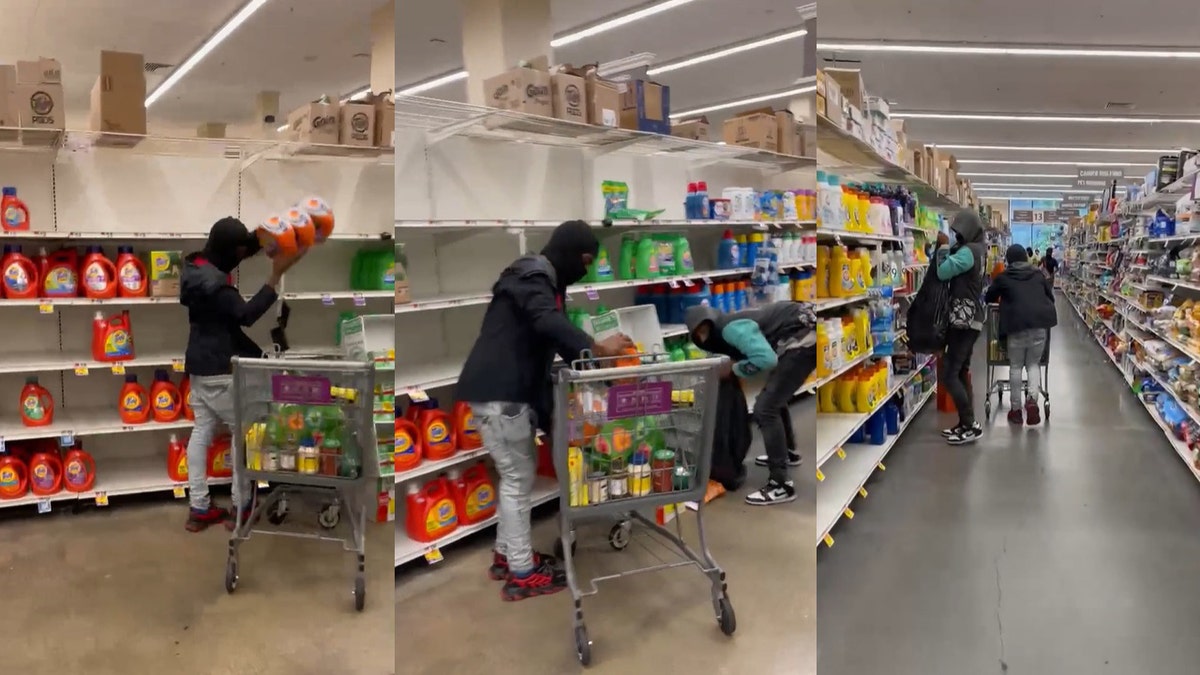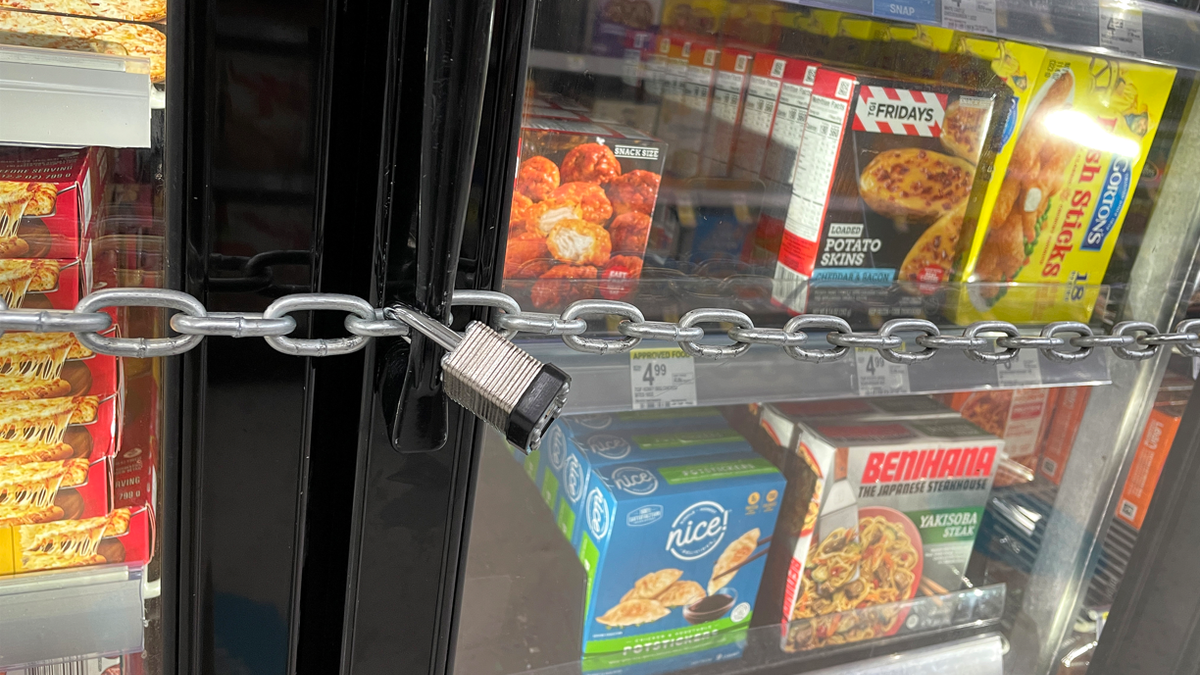Giant grocery store threatened by shoplifting: 'Enough is enough,' DC councilman says
Despite spending hundreds of thousands of dollars on upgrading its security equipment, theft is out of control at this Giant Food chain. (DC Councilman Trayon White)
Viral videos of store lootings have become such an evening news staple, they no longer shock. The recent attack on a California Nordstrom by 50 youths — resulting in approximately $100,000 in losses — stood out only for the gang’s use of bear spray on security guards (and for the inevitable "Bear Spray Posse" memes).
For so many Americans, such videos are now accepted as simply another marker for urban decay. So: Is this the permanent new normal?
And if so — what’s driving it?
ZERO CASH BAIL TO BLAME FOR 'BRAZEN' SMASH AND GRAB ROBBERIES IN LA, POLICE UNION SAYS
1. The post-Floyd 'criminal justice reform' movement
As a rebuke to the broken windows era of policing — in which an imposed sense of order was the key to preempting crime — legislatures across the country have instituted new regimes that are all carrot and no stick.

Shoplifters in Washington, D.C., were caught on video taking laundry detergent in the middle of the day. (Fox News)
The result has been a sense of impunity among some violators that borders on entitlement.
For instance, as even The New York Times has acknowledged, roughly one-third of all New York City shoplifting crimes are committed by a core group of just 327 perpetrators. For these perpetrators, the incentive to discontinue their current lifestyle has been removed — so they choose to continue. Imagine that.
That this behavior metastasizes can be demonstrated by a startling revelation. Again, according to the Times — not exactly an advocate for Draconian enforcement — over 90,000 delivery packages a day are stolen in New York City (you read that right). Tellingly, for 2019 (the year that statistic is from), the NYPD only recorded a total yearly number of 132,565 — roughly a day-and-a-half’s worth by the Times’ numbers.
So: where are the other 363½ days' worth of crime complaints?
2. Many crimes today go unreported, because victims feel the system won't help them
In the case of stolen packages, most victims have clearly decided "that’s just the way things are," and complain instead to Amazon and other shippers, who generally just ship a replacement (and if you don’t think that cost is passed onto consumers…).
In the shoplifting context, this manifests in the fact that many — if not most — shoplifting incidents go unreported. Shopkeepers fear the civil liability of an incident that blows up into a claim of injury by the perpetrator, which at least could drive up insurance costs. The security guards — often moonlighting cops who need the money — can’t afford to be involved in too many such incidents; again, insurance companies could end coverage (and they’d be fired).
Even police departments are incentivized to underplay shoplifting. Two-hundred dollars in stolen baby formula is, at worst, a petty larceny report after-the-fact. But a struggle between a security guard and a shoplifter bumps the incident to a robbery — one of the so-called "seven majors" that crime indices track. No precinct commander wants a robbery spike due to escalated petty thefts.
Is it any wonder New York City locks up its toothpaste?

A chain with padlocks secures freezer doors at a Walgreens store in San Francisco on July 18, 2023. The store locked its freezers with chains and padlocks to thwart shoplifters that have been hitting the store on a regular basis and stealing frozen pizzas and ice cream. (Justin Sullivan/Getty Images)
3. Many of these large shoplifting groups are now organized
The fact that 50 youths could arrive at a single location and simultaneously charge a luxury store — and that, as we’ve noted, this is not unique — points to an obvious level of coordination, most likely through the use of difficult-to-penetrate instant messages and encrypted phone apps like Telegram.
Alas, the value of this smash-and-grab tactic was amply demonstrated during the Summer 2020 riots. The lack of enforcement then must have struck many perpetrators as a revelation.
I don’t have to guess at that, by the way: I witnessed it. Firsthand.
Much as with the traditional mafia, organization is a great force multiplier. Today, the stolen goods are almost certainly fenced to buyers who flip the stuff for profit online, with the internet making the market global. It’s a difficult structure to break.
4. There is no avoiding the issue of race
That the videos almost always show groups of Black youths gang-rushing these stores has induced a cognitive dissonance, and collective silence, from our media class. Clearly, this is not how the criminal justice reforms were supposed to look. But there is simply no response within the media’s worldview that does not run the risk of eliciting the dreaded cry of "racism!"
And never mind the more lethal results of the reforms, in which young Black males are disproportionately the victims.
The results of all this are visible: residents fleeing, storefronts boarded up, neighborhoods bereft of even basic grocery stores. Our major cities have begun to look and feel gangrenous.
5. So, what's to be done?
This is the part where I am supposed to offer solutions and sunny predictions.
My answer is: nothing. There’s nothing to be done. The progressive canon underpinning these conditions is so entrenched that nuances like plummeting quality of life and corporate flight barely register.
And so, we’re faced with a discomfiting, even tragic, conclusion: yes, this is the new normal in our cities. Let’s not kid ourselves, folks — this is it.
If you can live with that, fine. If not, you have two options. You can (physically) fight back, as two convenience store owners did recently in a (predictably viral) video. As Jose Alba did. As Daniel Penny did. Thereby risking felony charges yourself.
Or: you can just leave. As so many residents are doing.
Alas, the value of this smash-and-grab tactic was amply demonstrated during the Summer 2020 riots. The lack of enforcement then must have struck many perpetrators as a revelation. I don’t have to guess at that, by the way: I witnessed it. Firsthand.
Are there any signs of an awakening? Perhaps. In Washington, D.C, a Black city councilman recently advocated for calling out the National Guard to combat crime conditions there. Not the best option. But at least D.C. has a public official capable of recognizing conditions on the ground.
Unlike Chicago — which recently rejected soft-on-crime Mayor Lori Lightfoot for equally soft-on-crime Mayor Brandon Johnson.
CLICK HERE FOR MORE FOX NEWS OPINION
Unlike San Francisco, where the federal government just told employees to work from home due to rampant crime.
And unlike New York, which not only refuses to renounce its sanctuary city status, but which has decided to close Rikers Island, its troubled local jail, thereby cutting the citywide prisoner bed count by 40%.
You think New York locks up nobody now? We’re about to cut the incarceration rate here by nearly half.
CLICK HERE TO GET THE FOX NEWS APP
In a town that incarcerates its toothpaste.
Do these sound like municipalities looking to reset "the new normal" to you?






